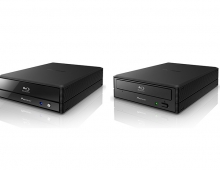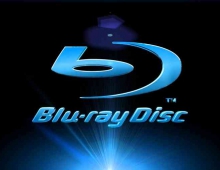
Future of rewritable DVDs to depend on competition over standards
The rewritable-DVD market will change beginning in 2003, with the standard for the product to be fully resolved. Confusion over the conflict among three kinds of specifications, "-RAM" "-RW" "+RW," which has lasted for two years, will finally be clarified. Following CD-R, DVD-R mediums will also undergo rapid price-cutting competition. Therefore, the scenario of the diffusion of rewritable DVDs is now in sight. This powerful movement could now go as far as redrawing the scenario of the shift to the optical disc, the next-generation of DVD. Moreover, the "Blu-ray Disc" standard has been decided upon as the next-generation of optical disc.
Resolving Confusion
The confusion over rewritable DVD formats -- with many formats existing at the same time -- will be resolved in two directions. One is that recording/playback equipment compatible with several formats will appear on the market by the end of 2002. The other is that the sales of the write-once, read-many mediums will increase, instead of sales of the rewritable mediums, which are the focus of arguments.
Machines compatible with several formats started to appear:
DVD-Multi drives: Capable of writing to and reading from All DVD-Forum related writable DVD media. Minimum supported media shall be DVD-R , DVD-RW and DVD-RAM. Supporting +RW/+R and CDR/RW is not the scope of "DVD-Multi" definition. "DVD-Multi" is the official standard of the DVD-Forum.
- Dual drives: Capable of writing to and reading from DVD-R/RW and +R/+RW media.
- Super Multi drives: DVD-Multi and +R/+RW writable functionality. Sony and Sanyo plan to release such drives in the next year.
Secondly, as for the mediums, the use of write-once, read-many mediums will see a brisk increase in 2002 and 2003.
A media maker predicted, "most of the mediums that customers use will be write-once, read-many type, and the number of rewritable mediums possessed by the users will be around two or three per person."
Also, since many of the users are already accustomed to utilizing CD-R discs, the write-once-only feature of the write-once, read-many type is received with no difficulty. In DVD recorders, where, at present, rewritable mediums are mainly taking an active role, a shift to write-once, read-many mediums will likely advance, too.
DVD-R for about US$1
After the conflict is resolved, rewritable DVDs will gain popularity swiftly, and price reductions of recording/playback equipment and mediums will accelerate.
First, price reduction of the recording medium will advance (see Graph). That will be caused by the oversupply and the intensification of competition by the increase in the number of makers and the influx of "super low-price mediums" by Taiwanese makers.
Recording mediums that were in short supply are now reaching a period of oversupply in the autumn to winter of 2002, because makers are preparing for increased production levels. Moreover, because the barrier to enter the write-once, read-many DVD is low for the makers that produce CD-R discs, the supply will continue increasing. According to an estimate by Fujiwara Roth Child Ltd., an optical-disc research company, the number of makers that will enter will exceed 20 companies.
Already, on the Internet, DVD-R media units priced at about US$1 have begun to appear.
Furthermore, the news came out that Princo Corp. of Taiwan presented a DVD-R disc with the OEM price of US$0.60 at Computex Taipei 2002, held in June 2002. It said that the price would be reduced to US$0.30 at the end of 2002.
Although the prices at volume retailers will not necessarily reach the same level immediately, "the market price will inevitably fall," said an official at a Japanese maker.
This rapid price-reduction trend, which could be called the "Taiwan shock," has also nearly arrived for recording/playback equipment. According to an engineer at an optical-disc manufacturing maker, several major makers in Taiwan are planning to enter this market as early as 2003. While optical disc makers are aiming for an OEM price of US$150 at the end of 2002, and around US$100 at the end of 2003, the price reduction pace will inevitably speed up. Some believe that the price will fall below US$100 by the end of 2003.
If so, an optical disc device will be embedded in volume-type PCs and this will no doubt accelerate the popularity. Demand will rise, which will start the cycle of reducing the production cost.
Life-Prolonging Plan for DVD to Emerge
If rewritable DVDs gain popularity, the shifting scenario to the DVD's next generation -- the optical disc -- may well require reexamination. A solution is needed as a bridge to the next generation while extending the present DVD technology as long as possible. The conventional idea is to use over-20GB next-generation optical discs. And this has been the common opinion for hour-long recordings of HDTV and SDTV programs. This is why nine audio-video makers in Japan, Europe and Korea have decided on the "Blu-ray Disc" standard, which is aimed at enlarging the capacity.
However, as for playback-only DVD-Videos, a technical examination is underway with a view to storing HDTV video of two hours or longer on a 8.5GB-medium with two layers on one side. A HDTV video package in a DVD-ROM will then be realized. This movement will naturally affect rewritable DVDs.
Another movement that also aims at hour-long recording is becoming clear. ESS Technology Inc. of the United States and others are making advancements in the development of encryption/decryption LSIs for DVD recorder/players compatible with MPEG-4 and Windows Media Video (WMV). When realized, hour-long recording/playback will be possible without using the next-generation optical disc.
Suddenly surfacing is another movement, where an approach is taken with a view toward realizing the next-generation optical disc that uses blue-violet laser while maintaining the same disc structure as the present DVDs. Progress toward a specification decision is advancing. NEC Corp. and Toshiba Corp. are taking the lead. It will use a disc composed of two substrates with 0.6mm thickness, the same as DVD, attached together.
As for the advantages, the two companies said: compared with the Blu-ray Disc system, compatibility between the present products and the next-generation products are attained more easily, production equipment can be diverted easily, and no cartridges are required. Although the recording capacity of one side (a single layer) is as small as 15GB to 20GB, it is compensated for by the high compression technology and the two-layer recording disc technology.
On the other hand, the Blu-ray Disc standard is also expected to maintain an affinity to the present DVD by retaining recording/playback functions. However, this could be costly depending on the way it would be produced. As for the mediums, many also believe that initially a cartridge will be required. Therefore, the medium is likely to appear to be different from DVDs, for the users.
Blu-ray Disc also has many advantages with regard to its potential, including more freedom of increasing recording capacity. The next-generation optical disc technology is now standing at a crossroads...
The confusion over rewritable DVD formats -- with many formats existing at the same time -- will be resolved in two directions. One is that recording/playback equipment compatible with several formats will appear on the market by the end of 2002. The other is that the sales of the write-once, read-many mediums will increase, instead of sales of the rewritable mediums, which are the focus of arguments.
Machines compatible with several formats started to appear:
DVD-Multi drives: Capable of writing to and reading from All DVD-Forum related writable DVD media. Minimum supported media shall be DVD-R , DVD-RW and DVD-RAM. Supporting +RW/+R and CDR/RW is not the scope of "DVD-Multi" definition. "DVD-Multi" is the official standard of the DVD-Forum.
- Dual drives: Capable of writing to and reading from DVD-R/RW and +R/+RW media.
- Super Multi drives: DVD-Multi and +R/+RW writable functionality. Sony and Sanyo plan to release such drives in the next year.
Secondly, as for the mediums, the use of write-once, read-many mediums will see a brisk increase in 2002 and 2003.
A media maker predicted, "most of the mediums that customers use will be write-once, read-many type, and the number of rewritable mediums possessed by the users will be around two or three per person."
Also, since many of the users are already accustomed to utilizing CD-R discs, the write-once-only feature of the write-once, read-many type is received with no difficulty. In DVD recorders, where, at present, rewritable mediums are mainly taking an active role, a shift to write-once, read-many mediums will likely advance, too.
DVD-R for about US$1
After the conflict is resolved, rewritable DVDs will gain popularity swiftly, and price reductions of recording/playback equipment and mediums will accelerate.
First, price reduction of the recording medium will advance (see Graph). That will be caused by the oversupply and the intensification of competition by the increase in the number of makers and the influx of "super low-price mediums" by Taiwanese makers.
Recording mediums that were in short supply are now reaching a period of oversupply in the autumn to winter of 2002, because makers are preparing for increased production levels. Moreover, because the barrier to enter the write-once, read-many DVD is low for the makers that produce CD-R discs, the supply will continue increasing. According to an estimate by Fujiwara Roth Child Ltd., an optical-disc research company, the number of makers that will enter will exceed 20 companies.
Already, on the Internet, DVD-R media units priced at about US$1 have begun to appear.
Furthermore, the news came out that Princo Corp. of Taiwan presented a DVD-R disc with the OEM price of US$0.60 at Computex Taipei 2002, held in June 2002. It said that the price would be reduced to US$0.30 at the end of 2002.
Although the prices at volume retailers will not necessarily reach the same level immediately, "the market price will inevitably fall," said an official at a Japanese maker.
This rapid price-reduction trend, which could be called the "Taiwan shock," has also nearly arrived for recording/playback equipment. According to an engineer at an optical-disc manufacturing maker, several major makers in Taiwan are planning to enter this market as early as 2003. While optical disc makers are aiming for an OEM price of US$150 at the end of 2002, and around US$100 at the end of 2003, the price reduction pace will inevitably speed up. Some believe that the price will fall below US$100 by the end of 2003.
If so, an optical disc device will be embedded in volume-type PCs and this will no doubt accelerate the popularity. Demand will rise, which will start the cycle of reducing the production cost.
Life-Prolonging Plan for DVD to Emerge
If rewritable DVDs gain popularity, the shifting scenario to the DVD's next generation -- the optical disc -- may well require reexamination. A solution is needed as a bridge to the next generation while extending the present DVD technology as long as possible. The conventional idea is to use over-20GB next-generation optical discs. And this has been the common opinion for hour-long recordings of HDTV and SDTV programs. This is why nine audio-video makers in Japan, Europe and Korea have decided on the "Blu-ray Disc" standard, which is aimed at enlarging the capacity.
However, as for playback-only DVD-Videos, a technical examination is underway with a view to storing HDTV video of two hours or longer on a 8.5GB-medium with two layers on one side. A HDTV video package in a DVD-ROM will then be realized. This movement will naturally affect rewritable DVDs.
Another movement that also aims at hour-long recording is becoming clear. ESS Technology Inc. of the United States and others are making advancements in the development of encryption/decryption LSIs for DVD recorder/players compatible with MPEG-4 and Windows Media Video (WMV). When realized, hour-long recording/playback will be possible without using the next-generation optical disc.
Suddenly surfacing is another movement, where an approach is taken with a view toward realizing the next-generation optical disc that uses blue-violet laser while maintaining the same disc structure as the present DVDs. Progress toward a specification decision is advancing. NEC Corp. and Toshiba Corp. are taking the lead. It will use a disc composed of two substrates with 0.6mm thickness, the same as DVD, attached together.
As for the advantages, the two companies said: compared with the Blu-ray Disc system, compatibility between the present products and the next-generation products are attained more easily, production equipment can be diverted easily, and no cartridges are required. Although the recording capacity of one side (a single layer) is as small as 15GB to 20GB, it is compensated for by the high compression technology and the two-layer recording disc technology.
On the other hand, the Blu-ray Disc standard is also expected to maintain an affinity to the present DVD by retaining recording/playback functions. However, this could be costly depending on the way it would be produced. As for the mediums, many also believe that initially a cartridge will be required. Therefore, the medium is likely to appear to be different from DVDs, for the users.
Blu-ray Disc also has many advantages with regard to its potential, including more freedom of increasing recording capacity. The next-generation optical disc technology is now standing at a crossroads...





















